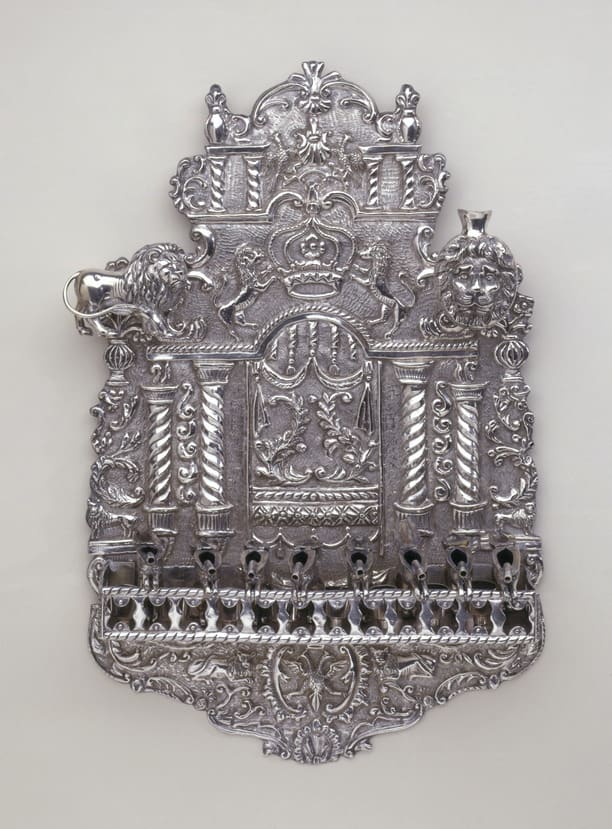
- Object Name:
- Hanukkah Lamp
- Artist/Maker:
- Inndustria
- Place Made:
- Cuzco, Peru
- Date:
- first half 20th century
- Medium:
- Silver: repoussé, traced, and cast
- Dimensions:
- 16 7/8 × 11 1/4 × 2 1/2 in. (42.9 × 28.6 × 6.4 cm)
- Credit Line:
- Gift of Dr. Harry G. Friedman
- Accession Number:
- F 1834
Not On View
This Peruvian-made lamp is a close imitation of a type of Polish lamp of which there is an example in the collection from Brody, dated 1787. Both pieces exhibit the multistory structure of Polish and Russian Torah arks, with two columned tiers, elaborate scrollwork on the sides, and the curtains in front of the ark doors. The balcony railing, the leaping lion oil containers, and even the double-headed eagle on the bottom have been faithfully copied in the Peruvian lamp. The South American artist has added some original touches in the form of the three-dimensional lion and lion head that serve as the shamash and oil container.
The history of this piece is unknown, and thus the circumstances of its commission remain intriguing. The availability of silver in a number of Central and South American countries led to the commissioning of Jewish ceremonial art for American consumption. This piece was probably intended for export, since the city name of Old Cuzco is in English. However, there were Jewish communities in Peru beginning in the late sixteenth century, and it is possible that this lamp was made for local use. These first settlers consisted of conversos, Sephardi Jews who were forced to convert but who secretly followed Jewish tradition. Beginning in the mid-nineteenth century, waves of immigration came from central Europe, North Africa, the Ottoman Empire, and finally Germany and eastern Europe, these last of Jews fleeing the Nazis. No community, however, is recorded as living in Cuzco.
The history of this piece is unknown, and thus the circumstances of its commission remain intriguing. The availability of silver in a number of Central and South American countries led to the commissioning of Jewish ceremonial art for American consumption. This piece was probably intended for export, since the city name of Old Cuzco is in English. However, there were Jewish communities in Peru beginning in the late sixteenth century, and it is possible that this lamp was made for local use. These first settlers consisted of conversos, Sephardi Jews who were forced to convert but who secretly followed Jewish tradition. Beginning in the mid-nineteenth century, waves of immigration came from central Europe, North Africa, the Ottoman Empire, and finally Germany and eastern Europe, these last of Jews fleeing the Nazis. No community, however, is recorded as living in Cuzco.
Information may change as a result of ongoing research.